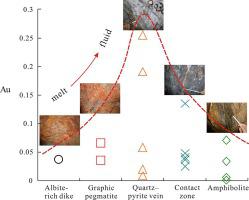Ore Geology Reviews ( IF 3.2 ) Pub Date : 2021-09-02 , DOI: 10.1016/j.oregeorev.2021.104444 Shuo Wang 1 , Yunhua Liu 1 , Yunchen Guo 2 , Qiang Zhang 2 , Jinlai Chen 2 , Xiaoyan Li 3 , Nan Deng 4

|
The Jinchangyu deposit is the largest Au lode deposit in eastern Hebei Province of China and is located along the northern margin of the North China Craton. It was previously thought that this deposit was a greenstone belt-type as the orebodies are controlled by ductile shear structures in amphibolite units of the Archean Zunhua Group. However, new geological and petrographic observations presented here show that the mineralization was actually controlled by the brittle schistosity in the amphibolite and the ore-bearing quartz–albite veins are actually albite-rich granite porphyry dikes that coexist with graphic pegmatite dikes. Based on geological and geochemical features, we propose that the Jinchangyu Au deposit is actually a magmatic–hydrothermal type formed by melt–fluid derived from a highly fractionated magma. The ore-bearing albite-rich granite porphyry and pegmatite dikes are metaluminous to weakly peraluminous, and belong to the low-K tholeiitic to shoshonitic and subalkaline series. All the samples have high SiO2, K2O + Na2O contents and differentiation index values, low CaO, MgO, P2O5, and TiO2 contents, are enriched in Th, U, Ta, Nb, Sr, Zr, and Hf, depleted in Ba, K, P, Ti, and δEu, and exhibit the tetrad rare earth element effect. The mineralogy and geochemistry indicate the dikes are highly fractionated I-type granites, and that the Jinchangyu Au deposit was generated during magmatic differentiation. δ34S values of pyrite vary from –6.3‰ to 4.2‰, and H–O isotopic compositions of quartz from quartz–pyrite veins indicate the mineralizing fluid had a predominantly magmatic source. Lead isotope ratios (206Pb/204Pb = 15.65–16.18, 207Pb/204Pb = 15.16–15.29) of pyrite in the quartz–pyrite veins indicate the ore-forming materials were derived from a mixed source containing mantle and crustal materials. Geochemical features indicate that the dikes formed in a post-collsional extensional tectonic setting during the Late Triassic, after closure of the Paleo-Asian Ocean. Combined with data from previous studies, we propose that the parental magma and ore-forming materials of the Jinchangyu Au deposit were derived from a mixed source containing mantle and crustal material, underwent extensive differentiation, and then sequentially formed the ore-bearing albite-rich granite porphyry dike dikes, graphic pegmatite dikes, and quartz–albite, quartz–pyrite, and quartz–carbonate veins.











































 京公网安备 11010802027423号
京公网安备 11010802027423号